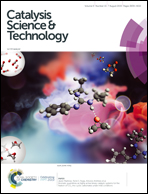Low-valence or tetravalent cation doping of manganese oxide octahedral molecular sieve (K-OMS-2) materials for nitrogen oxide emission abatement†
Abstract
Substitutionally doped oxide catalysts with abundant oxygen vacancy defects (OVDs) can effectively improve the catalytic activity efficiency. Here, transition metal (Zn, Fe, Zr, V, Mo, or W)-doped cryptomelane manganese oxide (K-OMS-2) catalysts were synthesized via a reflux method. The characterization and density functional theory plus U (DFT+U) results demonstrated that low-valence or tetravalent metals could be substituted for the Mn in the framework of K-OMS-2 catalysts, facilitating the production of OVDs. In contrast, higher-valence metals (Mo and W) compared to tetravalent manganese could not produce the corresponding Mo-K-OMS-2 and W-K-OMS-2, but only MoO3 and WO3, respectively. Substitutionally doping the Mn in the framework of K-OMS-2 with Zn, Fe, and Zr enhanced the selective catalytic reduction with NH3 (NH3-SCR) of nitrogen oxides, while dopants such as V, Mo, and W hindered the NH3-SCR activity. Moreover, the higher average oxidation state (AOS) of manganese and the stronger activity of OVDs in low-valence or tetravalent metal-doped K-OMS-2 were two crucial factors in determining NH3-SCR.



 Please wait while we load your content...
Please wait while we load your content...